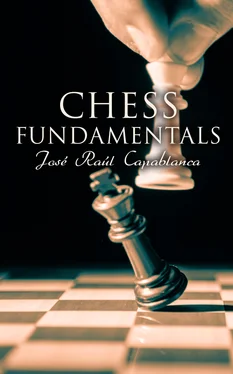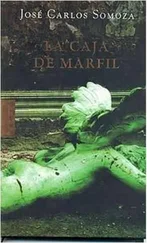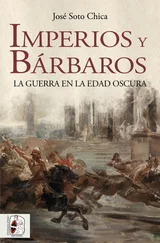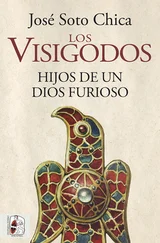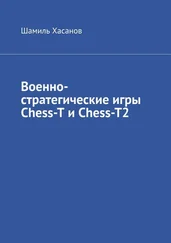2. PAWN PROMOTION
The gain of a Pawn is the smallest material advantage that can be obtained in a game; and it often is sufficient to win, even when the Pawn is the only remaining unit, apart from the Kings. It is essential, speaking generally, that
the King should be in front of his Pawn, with at least one intervening square .
If the opposing King is directly in front of the Pawn, then the game cannot be won. This can best be explained by the following examples.
Example 5.
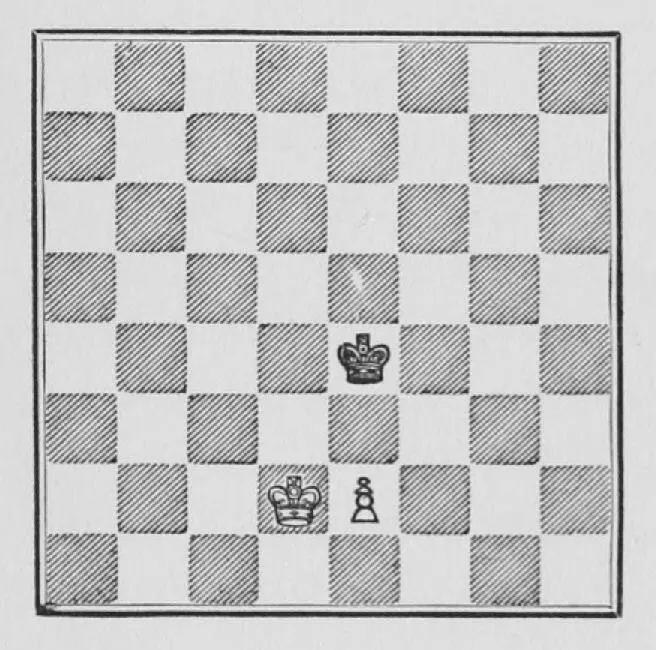
The position is drawn, and the way to proceed is for Black to keep the King always directly in front of the Pawn, and when it cannot be done, as for instance in this position because of the White King, then the Black King must be kept in front of the White King. The play would proceed thus: 1 P - K 3, K - K 4; 2 K - Q 3, K - Q 4. This is a very important move. Any other move would lose, as will be shown later. As the Black King cannot be kept close up to the Pawn, it must be brought as far forward as possible and, at the same time, in front of the White King.
3 P - K 4 ch, K - K 4; 4 K - K 3, K - K 3; 5 K - B 4, K - B 3. Again the same case. As the White King comes up, the Black King must be kept in front of it, since it cannot be brought up to the Pawn.
6 P - K 5 ch, K - K 3; 7 K - K 4, K - K 2; 8 K - Q 5, K - Q 2; 9 P - K 6 ch, K - K 2; 10 K - K 5, K - K 1; 11 K - Q 6, K - Q 1. If now White advances the Pawn, the Black King gets in front of it and White must either give up the Pawn or play K - K 6, and a stale mate results. If instead of advancing the Pawn White withdraws his King, Black brings his King up to the Pawn and, when forced to go back, he moves to K in front of the Pawn ready to come up again or to move in front of the White King, as before, should the latter advance.
The whole mode of procedure is very important and the student should become thoroughly conversant with its details; for it involves principles to be taken up later on, and because many a beginner has lost identical positions from lack of proper knowledge. At this stage of the book I cannot lay too much stress on its importance.
Example 6.—In this position White wins, as the King is in front of his Pawn and there is one intervening square.
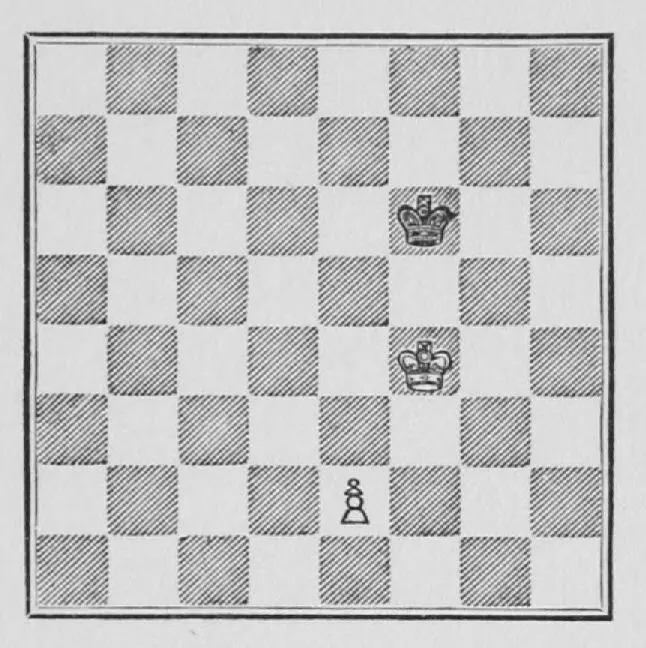
The method to follow is to
advance the King as far as is compatible with the safety of the Pawn and never to advance the Pawn until it is essential to its own safety .
Thus:
1. K - K 4, K - K 3.
Black does not allow the White King to advance, therefore White is now compelled to advance his Pawn so as to force Black to move away. He is then able to advance his own King.
2. P - K3, K - B 3; 3. K - Q 5, K - K 2.
If Black had played 3...K - B 4, then White would be forced to advance the Pawn to K 4, since he could not advance his King without leaving Black the opportunity to play K - K 5, winning the Pawn. Since he has not done so, it is better for White not to advance the Pawn yet, since its own safety does not require it, but to try to bring the King still further forward. Thus:
4. K - K 5, K - Q 2; 5. K - B 6, K - K 1.
Now the White Pawn is too far back and it may be brought up within protection of the King.
6. P - K 4, K - Q 2.
Now it would not do to play K - B 7, because Black would play K - Q 3, and White would have to bring back his King to protect the Pawn. Therefore he must continue.
7. P - K 5, K - K 1.
Had he moved anywhere else, White could have played K - B 7, followed by the advance of the Pawn to K 6, K 7, K 8; all these squares being protected by the King. As Black tries to prevent that, White must now force him to move away, at the same time always keeping the King in front of the Pawn. Thus:
8. K - K 6.
P - K 6 would make it a draw, as Black would then play K - B, and we would have a position similar to the one explained in connection with Example 5.
8...K - B 1; 9. K - Q 7.
King moves and the White Pawn advances to K 8, becomes a Queen, and it is all over.
This ending is like the previous one, and for the same reasons should be thoroughly understood before proceeding any further.
3. PAWN ENDINGS
I shall now give a couple of simple endings of two Pawns against one, or three against two, that the reader may see how they can be won. Fewer explanations will be given, as it is up to the student to work things out for himself. Furthermore, nobody can learn how to play well merely from the study of a book; it can only serve as a guide and the rest must be done by the teacher, if the student has one; if not, the student must realise by long and bitter experience the practical application of the many things explained in the book.
Example 7.
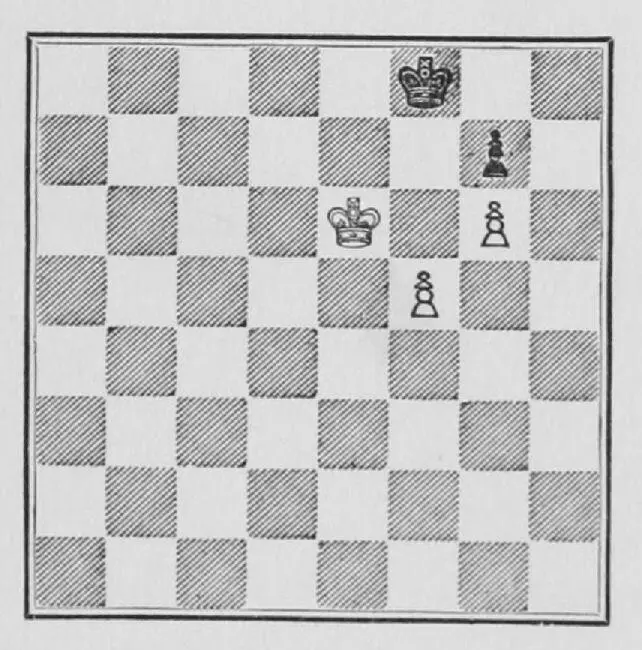
In this position White cannot win by playing 1 P - B 6, because Black plays, not P × P, which would lose, but 1...K - Kt 1, and if then 2 P × P, K × P, and draws, as shown in a previous case. If 2 P - B 7 ch, K - B 1, and White will never be able to Queen his Pawn without losing it. If 2 K - K 7, P × P; 3 K × P, K - B 1, and draws. White, however, can win the position given in the diagram by playing:
1 K - Q 7, K - Kt 1; 2 K - K 7, K - R 1; 3 P - B 6, P × P. If 3...K - Kt 1; 4 P - B 7 ch, K - R 1; 5 P - B 8 (Q) mate.
4 K - B 7, P - B 4; 5 P - Kt 7 ch, K - R 2; 6 P - Kt 8 (Q) ch, K - R 3; 7 Q - Kt 6 mate.
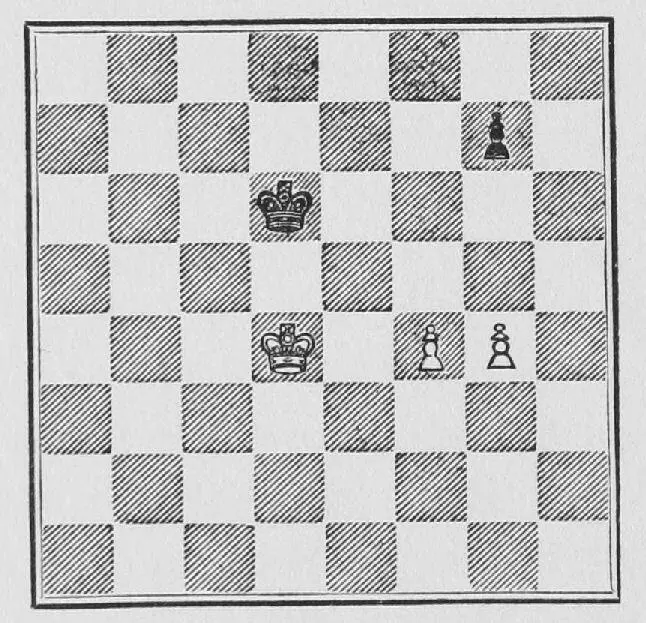
Example 8.—In the above position White can't win by 1 P - B 5. Black's best answer would be P - Kt 3 draws. (The student should work this out.) He cannot win by 1 P - Kt 5, because P - Kt 3 draws. (This, because of the principle of the " opposition " which governs this ending as well as all the Pawn-endings already given, and which will be explained more fully later on.)
White can win, however, by playing: 1 K - K 4, K - K 3. (If 1...P - Kt 3; 2 K - Q 4, K - K 3; 3 K - B 5, K - B 3; 4 K - Q 6, K - B 2; 5 P - Kt 5, K - Kt 2; 6 K - K 7, K - Kt 1; 7 K - B 6, K - R 2; 8 K - B 7 and White wins the Pawn.)
2 P - B 5 ch, K - B 3; 3 K - B 4, P - Kt 3. (If this Pawn is kept back we arrive at the ending shown in Example 7.) 4 P - Kt 5 ch, K - B 2; 5 P - B 6, K - K 3; 6 K - K 4, K - B 2; 7 K - K 5, K - B 1. White cannot force his Bishop's Pawn into Q (find out why), but by giving his Pawn up he can win the other Pawn and the game. Thus:
8 P - B 7, K × P; 9 K - Q 6, K - B 1; 10 K - K 6, K - Kt 2; 11 K - K 7, K - Kt 1; 12 K - B 6, K - R 2; 13 K - B 7, K - R 1; 14 K × P , K - Kt 1.
There is still some resistance in Black's position. In fact, the only way to win is the one given here, as will easily be seen by experiment.
15 K - R 6 (if K - B 6, K - R 2; and in order to win White must get back to the actual position, as against 16 P - Kt 6 ch, K - R 1 draws), K - R 1; 16 P - Kt 6, K - Kt 1; 17 P - Kt 7, K - B 2; 18 K - R 7, and White queens the Pawn and wins.
This ending, apparently so simple, should show the student the enormous difficulties to be surmounted, even when there are hardly any pieces left, when playing against an adversary who knows how to use the resources at his disposal, and it should show the student, also, the necessity of paying strict attention to these elementary things which form the basis of true mastership in Chess.
Читать дальше
